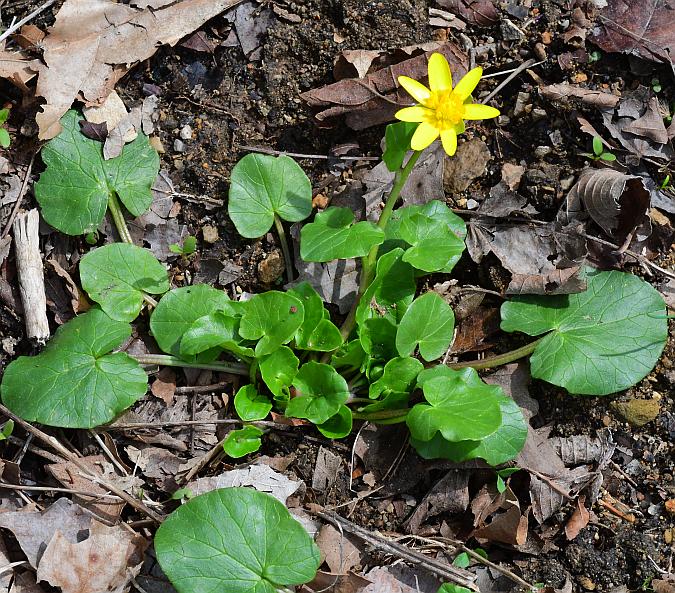Ranunculus ficaria L.
Lesser Celandine

Introduced
CC = *
CW = 0
MOC = 2
© SRTurner
Ranunculus ficaria L.Lesser Celandine | |
 |
Introduced CC = * CW = 0 MOC = 2 |
© SRTurner |
|
Family - Ranunculaceae Habit - Perennial forb, from a mixture of slender, fibrous roots and tuberous-thickened roots.
Stems - Loosely ascending, to 30 cm, often from a spreading base, not rooting at the lower nodes, glabrous, with small, white, ellipsoid to globose bulbils forming in the leaf axils after flowering has begun.
Leaves - Basal and alternate, or appearing opposite. Basal leaves long-petiolate, the blade 1.8-4.0 cm long, 2-4 cm wide, broadly heart-shaped to kidney-shaped or semicircular, simple, unlobed, the base truncate or cordate, the margins otherwise scalloped to nearly entire. Stem leaves similar to the basal leaves, but smaller, short-petiolate, and with the margins more often entire. Petioles flared and partially sheathing at the base.
Inflorescence - Flowers axillary or terminal at branch tips, long-pedunculate with a pair of small bractlike leaves at the base.
Flowers - Sepals usually 3, 4-9 mm long, spreading, pouched or saclike at the base. Petals 7-10 (more in doubled forms), 10-17 mm long, 3-7 mm wide, broadly oblanceolate to obovate, longer than the sepals, bright yellow, glossy. Stamens numerous, the anthers yellow. Styles absent.
Fruits - Rarely produced. When present, the head of achenes up to 4 or 5 mm long at maturity, more or less hemispheric, the receptacle glabrous or short-hairy. Achenes 2.6-2.8 mm long, turgid, not angular, the wall thick, smooth, minutely hairy, the beak absent. Flowering - March - May. Habitat - Bottomland forests, streambanks, lawns, roadsides, and disturbed, usually shaded areas. Origin - Native to Eurasia. Lookalikes - Other species of Ranunculus, also Caltha palustris. Other info. - Lesser celandine is an introduced species resembling several other members of the Ranunculus genus, to which it is not closely related. It is sometimes segregated in its own genus, Ficaria, with this species being F. verna. It is differentiated from other Missouri buttercups by the simple, unlobed leaves, 3 sepals, and small round bulbils formed in leaf axils after flowering. At present the plant is relatively uncommon in Missouri, thus far being reported from only two counties. Photographs taken at Powder Valley Conservation Area, St. Louis County, MO, 4-4-2022 (SRTurner). |